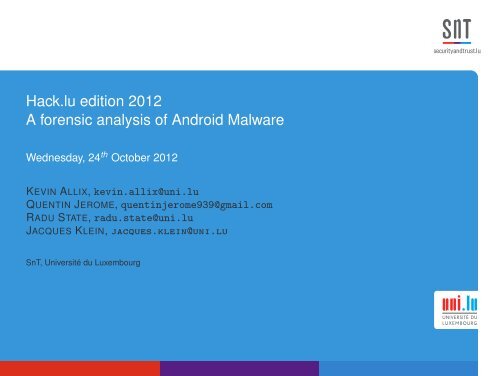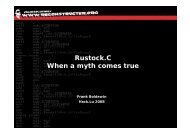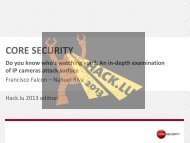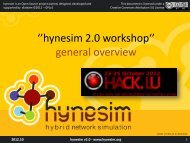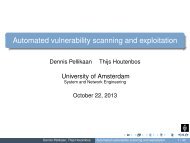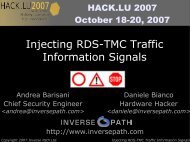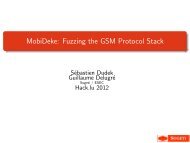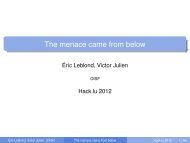Hack.lu edition 2012 A forensic analysis of Android Malware
Hack.lu edition 2012 A forensic analysis of Android Malware
Hack.lu edition 2012 A forensic analysis of Android Malware
- No tags were found...
Create successful ePaper yourself
Turn your PDF publications into a flip-book with our unique Google optimized e-Paper software.
<strong>Hack</strong>.<strong>lu</strong> <strong>edition</strong> <strong>2012</strong>A <strong>forensic</strong> <strong>analysis</strong> <strong>of</strong> <strong>Android</strong> <strong>Malware</strong>Wednesday, 24 th October <strong>2012</strong>KEVIN ALLIX, kevin.allix@uni.<strong>lu</strong>QUENTIN JEROME, quentinjerome939@gmail.comRADU STATE, radu.state@uni.<strong>lu</strong>JACQUES KLEIN, jacques.klein@uni.<strong>lu</strong>SnT, Université du Luxembourg
Be scared <strong>of</strong> <strong>Malware</strong>!<strong>Android</strong> <strong>Malware</strong>At least one story in the news every single weekA target <strong>of</strong> choice because <strong>of</strong> the amount <strong>of</strong> data stored onsmartphonesAccording to Antivirus vendors. . .You should be scaredYou should buy their productK. Allix, Q. Jerome (SnT) <strong>Hack</strong>.<strong>lu</strong> <strong>Hack</strong>.<strong>lu</strong> <strong>2012</strong>-24-10 1 / 33
The Starting PointA dataset <strong>of</strong> <strong>Android</strong> <strong>Malware</strong>1258 malwarehttp://www.malgenomeproject.orgDissecting <strong>Android</strong> <strong>Malware</strong>: Characterization and Evo<strong>lu</strong>tionYajin Zhou, Xuxian JiangProceedings <strong>of</strong> the 33rd IEEE Symposium on Security andPrivacy (Oakland <strong>2012</strong>) San Francisco, CA, May <strong>2012</strong>A dataset <strong>of</strong> clean <strong>Android</strong> ApplicationsCollected from Google Play. . .. . . and from alternative MarketsK. Allix, Q. Jerome (SnT) <strong>Hack</strong>.<strong>lu</strong> <strong>Hack</strong>.<strong>lu</strong> <strong>2012</strong>-24-10 2 / 33
Crawling for apps. . . ISeveral marketsGoogle play (<strong>Android</strong> Market) The <strong>of</strong>ficial marketAppChina The biggest alternative marketSlideme U.S. Based market, free and paid appsFreewareLovers German company, Works with a browser!Pro<strong>Android</strong> Russian market for free appsTorrents BitTorrent seems to be a popular way <strong>of</strong> getting apps. . .Genome The <strong>Malware</strong> datasetK. Allix, Q. Jerome (SnT) <strong>Hack</strong>.<strong>lu</strong> <strong>Hack</strong>.<strong>lu</strong> <strong>2012</strong>-24-10 3 / 33
Crawling for apps. . . IIMarkets way not want to be scraped :(Google play uses an overly complex protocol, with authenticationand scraping counter-measures (even for free apps)AppChina enforces drastic scraping protections: 1Mb/s bandwidthlimitation, several-hour ban if using more than one connectionK. Allix, Q. Jerome (SnT) <strong>Hack</strong>.<strong>lu</strong> <strong>Hack</strong>.<strong>lu</strong> <strong>2012</strong>-24-10 4 / 33
Crawling for apps. . . IIIWhat we collectedTable: Number <strong>of</strong> Apps for each marketMarket name App NumberGoogle 51,885AppChina 63,476Slideme 15,409FreewareLovers 4,119Pro<strong>Android</strong> 2,633Torrents 5,255Genome 1,258total 144,035total (dedup) 137,105K. Allix, Q. Jerome (SnT) <strong>Hack</strong>.<strong>lu</strong> <strong>Hack</strong>.<strong>lu</strong> <strong>2012</strong>-24-10 5 / 33
The Metadata Approach I<strong>Android</strong> ApplicationsDistributed as Single-file .apk PackagesJust a zip file that contains:Compiled Code (Dalvik Bytecode)A Manifest fileResources (images, sounds, . . . )One Certificate (or more than one)A signature file→ Apps travel unmodified from Authors’ computer to users’smartphones. No tinkering done by MarketsK. Allix, Q. Jerome (SnT) <strong>Hack</strong>.<strong>lu</strong> <strong>Hack</strong>.<strong>lu</strong> <strong>2012</strong>-24-10 6 / 33
The Metadata Approach IIQuestionsCan we find some patterns in the metadata?Can we find different patterns for <strong>Malware</strong>?We Focus on two metadata:Packaging TimestampCertificateK. Allix, Q. Jerome (SnT) <strong>Hack</strong>.<strong>lu</strong> <strong>Hack</strong>.<strong>lu</strong> <strong>2012</strong>-24-10 7 / 33
Timestamps160Total number <strong>of</strong> appsNumber <strong>of</strong> malware140Number <strong>of</strong> applications packaged that day12010080604040462088820 0 1 1 0 1 1300202011-06-02 2011-06-04 2011-06-06 2011-06-08 2011-06-10 2011-06-12 2011-06-14 2011-06-16K. Allix, Q. Jerome (SnT) <strong>Hack</strong>.<strong>lu</strong> <strong>Hack</strong>.<strong>lu</strong> <strong>2012</strong>-24-10 8 / 33
Timestamps: Fun Facts I<strong>Malware</strong> come in batchesThe 1258 known <strong>Malware</strong> were packaged on only 244 differentdays, while they cover ∼ 3 yearsRecord day: 2011-09-21 (51 malware, nearly 25% <strong>of</strong> all apps thatday)Only 72 malware (5.7%) were packaged a day when no othermalware was packaged.K. Allix, Q. Jerome (SnT) <strong>Hack</strong>.<strong>lu</strong> <strong>Hack</strong>.<strong>lu</strong> <strong>2012</strong>-24-10 9 / 33
Timestamps: Fun Facts II<strong>Malware</strong> Authors can do much betterWe counted 78 cases where at least two malware were packagedin the same secondAt 15 instances, four or more malware were packaged in the samesecondTwo <strong>of</strong> those instances saw ten or more new malware beingpackaged.This strong time locality suggests that malware writers have set uptools to automate the malware packaging processK. Allix, Q. Jerome (SnT) <strong>Hack</strong>.<strong>lu</strong> <strong>Hack</strong>.<strong>lu</strong> <strong>2012</strong>-24-10 10 / 33
Distribution over days <strong>of</strong> weekDistribution over each day <strong>of</strong> the week for each marketMarket Mon Tue Wed Thu Fri Sat SunGoogle 14.58% 15.85% 16.67% 16.32% 16.23% 10.32% 10.04%Appchina 15.68% 14.35% 15.99% 18.03% 17.99% 8.24% 9.73%Slideme 13.67% 15.57% 15.15% 14.81% 16.66% 12.28% 11.86%Freewarelovers 14.42% 15.71% 15.88% 17.31% 14.30% 10.59% 11.80%Proandroid 15.23% 17.17% 16.98% 15.19% 15.15% 9.84% 10.44%torrents 15.76% 14.92% 15.53% 15.4% 15.30% 11.76% 11.49%genome 14.31% 24.72% 18.84% 16.45% 13.75% 5.48% 6.44%Reading: From all applications that were fetched from the Googlemarket, 7565 (14.58%) were packaged a monday.K. Allix, Q. Jerome (SnT) <strong>Hack</strong>.<strong>lu</strong> <strong>Hack</strong>.<strong>lu</strong> <strong>2012</strong>-24-10 11 / 33
Distribution over hoursPercent876543218765432100 2 4 6 8 10 12 14 16 18 20 22 0 0 2 4 6 8 10 12 14 16 18 20 22GoogleAppchina0Percent11111010998877665544332211000 2 4 6 8 10 12 14 16 18 20 22 0GenomeDistribution <strong>of</strong> applications over hours for three marketsK. Allix, Q. Jerome (SnT) <strong>Hack</strong>.<strong>lu</strong> <strong>Hack</strong>.<strong>lu</strong> <strong>2012</strong>-24-10 12 / 33
CertificatesCertificate ReuseTable: Number <strong>of</strong> Apps and certificates for each marketMarket name Apps Cert Number Apps per certGoogle 51,885 17,028 3AppChina 63,476 13,193 4.8Slideme 15,409 5,758 2.7FreewareLovers 4,119 1,367 3Pro<strong>Android</strong> 2,633 1,371 1.9Torrents 5,255 1,700 3.1Genome 1,258 134 9.4Total (dedup) 137,105 31,226 4.4<strong>Malware</strong> authors are more likely to reuse certificatesK. Allix, Q. Jerome (SnT) <strong>Hack</strong>.<strong>lu</strong> <strong>Hack</strong>.<strong>lu</strong> <strong>2012</strong>-24-10 13 / 33
Inter<strong>lu</strong>deThe Question. . .We collected a grand total <strong>of</strong> 31,226 unique CertificatesCan you guess how many <strong>of</strong> those are not self-signed?K. Allix, Q. Jerome (SnT) <strong>Hack</strong>.<strong>lu</strong> <strong>Hack</strong>.<strong>lu</strong> <strong>2012</strong>-24-10 14 / 33
Inter<strong>lu</strong>deThe Question. . .We collected a grand total <strong>of</strong> 31,226 unique CertificatesCan you guess how many <strong>of</strong> those are not self-signed?Hint: Be pessimisticK. Allix, Q. Jerome (SnT) <strong>Hack</strong>.<strong>lu</strong> <strong>Hack</strong>.<strong>lu</strong> <strong>2012</strong>-24-10 14 / 33
Inter<strong>lu</strong>deThe Question. . .We collected a grand total <strong>of</strong> 31,226 unique CertificatesCan you guess how many <strong>of</strong> those are not self-signed?Hint: Be pessimistic31K. Allix, Q. Jerome (SnT) <strong>Hack</strong>.<strong>lu</strong> <strong>Hack</strong>.<strong>lu</strong> <strong>2012</strong>-24-10 14 / 33
K. Allix, Q. Jerome (SnT) <strong>Hack</strong>.<strong>lu</strong> <strong>Hack</strong>.<strong>lu</strong> <strong>2012</strong>-24-10 15 / 33
But then. . . What are those certificatesactually certifying?Not any kind <strong>of</strong> Identification. . .More precisely, not any kind <strong>of</strong> trustable IdentificationSame OriginNonetheless, a self-signed certificate allows to prove that twoapps have the same originSame-Origin actually useful on <strong>Android</strong> (Update, Inter-Appcommunication)K. Allix, Q. Jerome (SnT) <strong>Hack</strong>.<strong>lu</strong> <strong>Hack</strong>.<strong>lu</strong> <strong>2012</strong>-24-10 16 / 33
A selection <strong>of</strong> top <strong>Malware</strong> certificates. . .Apps# <strong>Malware</strong># Certificate Issuer & Owner3266 196 EMAILADDRESS=android@android.com,CN=<strong>Android</strong>, OU=<strong>Android</strong>, O=<strong>Android</strong>,L=Mountain View, ST=California, C=US167 167 C=keji0003281 165 CN=PhoneSniper, OU=Phone, O=Phone,L=china, ST=shenzhen, C=cn98 98 CN=kejikeji, OU=kejikeji, O=kejikeji,L=kejikeji, ST=kejikeji, C=kejikeji102 95 OU=Google Inc., C=US52 52 CN=Fujian Kaimo Network Tech30 30 CN=a, OU=a, O=a, L=a, ST=a, C=a24 21 CN=Sexy19 19 C=012 12 CN=lzq, OU=lzq, O=kdsjfkl, L=dlkfjkl,ST=fwekfj, C=430034K. Allix, Q. Jerome (SnT) <strong>Hack</strong>.<strong>lu</strong> <strong>Hack</strong>.<strong>lu</strong> <strong>2012</strong>-24-10 17 / 33
Who cares anyway?Developers don’t. . .Most <strong>of</strong> them don’t bother to put relevant data into their certificatesAnd when it looks relevant, it’s probably copy/pasted directly fromthe first tutorial <strong>of</strong> a Google searchCertificate is just the thing Eclipse is complaining about. . .Users don’t neitherThey don’t know what a certificate isEven if they knew, they’re never presented any certificate-relatedinformation anyway. . .K. Allix, Q. Jerome (SnT) <strong>Hack</strong>.<strong>lu</strong> <strong>Hack</strong>.<strong>lu</strong> <strong>2012</strong>-24-10 18 / 33
K. Allix, Q. Jerome (SnT) <strong>Hack</strong>.<strong>lu</strong> <strong>Hack</strong>.<strong>lu</strong> <strong>2012</strong>-24-10 19 / 33
Further experimentsQuestionIs it possible to use metadata to improve our chances to find malware ?Why ?It could be interesting for malware <strong>analysis</strong>. Dealing with a reduced set<strong>of</strong> applications where the density <strong>of</strong> malware is higher than a randompicking approach would be an asset.Which metric to observe ?We choose to screen certificates that signed more apps than athreshold per dayMax = the cert. that signed the most <strong>of</strong> application in a given dayK. Allix, Q. Jerome (SnT) <strong>Hack</strong>.<strong>lu</strong> <strong>Hack</strong>.<strong>lu</strong> <strong>2012</strong>-24-10 20 / 33
Graph 1K. Allix, Q. Jerome (SnT) <strong>Hack</strong>.<strong>lu</strong> <strong>Hack</strong>.<strong>lu</strong> <strong>2012</strong>-24-10 21 / 33
Graph 2NoteIf there is still malware in the market we would be able to catch some <strong>of</strong> them basedon this metric !!!For identifying suspicious certificates we have to take those that have signedbetween 3 and 11 apps by day.K. Allix, Q. Jerome (SnT) <strong>Hack</strong>.<strong>lu</strong> <strong>Hack</strong>.<strong>lu</strong> <strong>2012</strong>-24-10 22 / 33
ExperimentsDescriptionRetrieve in the market all certificates who signed a given number<strong>of</strong> applications on a daily basisGet applications signed by each certificates on those daysGet the proportion <strong>of</strong> malicious apps in this setParametersWe chose to take 2
ResultsResultsWe isolated 6,186 applications on over 52,000 appsIn this subset 1,162 (i.e. 18.78%) are considered as maliciousaccording to Dr. WebSome stats on this subset678 cert.6,186 applications -> avg=9.12 apps/cert678 certs. have signed 15,914 distinct apps in Google play678 certs. have signed 29,881 in the whole datasetK. Allix, Q. Jerome (SnT) <strong>Hack</strong>.<strong>lu</strong> <strong>Hack</strong>.<strong>lu</strong> <strong>2012</strong>-24-10 24 / 33
But, how many we would catch by pickingapps randomly in the market ?According to Dr. WebAbout 10.0% <strong>of</strong> applications are malicious (Surprised ?)Most <strong>of</strong> the malware detected are adware, spywareK. Allix, Q. Jerome (SnT) <strong>Hack</strong>.<strong>lu</strong> <strong>Hack</strong>.<strong>lu</strong> <strong>2012</strong>-24-10 25 / 33
QuestionWe have what we are looking for by picking in market categoriesYes but in our approach we did not take yet the information <strong>of</strong> malware distribution indifferent categoriesLet’s see if we can rely on packaging pattern for isolating malware in categoriesExample : The APP_WALLPAPER categoryBy observing the same metric (i.e. certs. which have signed the most application on agiven day)We isolate 334 apps for Sig. by cert. > 2272 (81.44%) are ’malicious’272=42% <strong>of</strong> malware in this categoryNoteThis search works also inside categories. We can increase our probability <strong>of</strong> findingmalware.K. Allix, Q. Jerome (SnT) <strong>Hack</strong>.<strong>lu</strong> <strong>Hack</strong>.<strong>lu</strong> <strong>2012</strong>-24-10 26 / 33
Partial conc<strong>lu</strong>sionIt does not seems to scale to build a detection mechanismThis metric does not seem to generalize enough malware.We can use this to isolate a subset where we have more chances t<strong>of</strong>ind ’malicious’ applicationsUsing the packaged apps by certificate metric we were able to isolate :A set where the probability to find malware is almost 2 timeshigher than a random selection in the marketThis technique can be used as a first step to find malwareBy analyzing data we can observe strange ’programming’ patterns ...K. Allix, Q. Jerome (SnT) <strong>Hack</strong>.<strong>lu</strong> <strong>Hack</strong>.<strong>lu</strong> <strong>2012</strong>-24-10 27 / 33
The best android programmer ever seenThe first and second placeThe 29th <strong>of</strong> february, 2008 between 10am and 11amEMAILADDRESS=android@android.com, CN=<strong>Android</strong>, OU=<strong>Android</strong>, O=<strong>Android</strong>,L=Mountain View, ST=California, C=US signed 615 appssha1 : 61ED377E85D386A8DFEE6B864BD85B0BFAA5AF81Damn it seems to be leaked certificate !The same day between 8am and 9amThe same certificate signed 369 apps. Very tough morning for a developer.The 25th <strong>of</strong> May, <strong>2012</strong> between 3pm and 4pmCN=Emin KURA, OU=Development, O=TRISTIT, L=Istanbul, ST=Bahcesehir, C=TRsigned 229 appssha1 : 952F56BCA55EE75B64CBF0B245E9E6D334D45C42K. Allix, Q. Jerome (SnT) <strong>Hack</strong>.<strong>lu</strong> <strong>Hack</strong>.<strong>lu</strong> <strong>2012</strong>-24-10 28 / 33
The prize <strong>of</strong> the country that developed themost malware is for ...This ranking is built from applications identified as malware by Dr. WebCountry Nb <strong>of</strong> malware Distinct Cert. App. by certUSA 765 116 6.6China 303 50 6.1India 297 60 4.95Italy 190 19 10UK 127 14 9.1Russia 88 12 7.3France 64 7 9.1And the prize for most motivated malware developer is for ...ItalyK. Allix, Q. Jerome (SnT) <strong>Hack</strong>.<strong>lu</strong> <strong>Hack</strong>.<strong>lu</strong> <strong>2012</strong>-24-10 29 / 33
The mystery <strong>of</strong> leaked certificateWanted : EMAILADDRESS=android@android.com, CN=<strong>Android</strong>,OU=<strong>Android</strong>, O=<strong>Android</strong>, L=Mountain View, ST=California, C=USWhy a malicious author would like to use such a certificate ?Because they can use applications signed by the same certificatewithout asking permissions. Can lead to Application level privilegeescalation !Why a non rogue developer would like to use such a certificate ?We do not know ...Application like : com.custom.lwp.sexybooty3.apk have beensigned by such a certificate and it does not seem to be a Googleapplication28 apps signed by this cert. on our snapshot <strong>of</strong> Google Play (notdetected as malicious)K. Allix, Q. Jerome (SnT) <strong>Hack</strong>.<strong>lu</strong> <strong>Hack</strong>.<strong>lu</strong> <strong>2012</strong>-24-10 30 / 33
Desktop malware VS mobile OS malwareThe term <strong>of</strong> ’android malware’ does not seem to be well definedWhat is really an android malware ?Apps that leaks iMEI, IMSI are malware ?A lot <strong>of</strong> advertisement libraries do it !Are apps that propose you other applications are malware ? Which kind <strong>of</strong> appsare proposed, malware/goodware ...Even AV cannot give us the answerFor a set <strong>of</strong> 2,000 apps randomly picked in the marketAvast reported 11 threatsAgainst 207 for Dr. WebAvast seems to report only critical threats like Plankton malware while Dr. Web isfocused on adware, spyware as well.K. Allix, Q. Jerome (SnT) <strong>Hack</strong>.<strong>lu</strong> <strong>Hack</strong>.<strong>lu</strong> <strong>2012</strong>-24-10 31 / 33
Open questionsWhy a ’normal’ developer would like to package a lot <strong>of</strong> applications ina short time ?Because he wants to spread malware ?He uses shared code ?Is the certificate system put in place is efficient ?No trust chainDoes a self signed certificate makes sense ?The data shows us that the link between a true identity and a certificateis broken due to the self signed mechanism. Thus the only thing thatwe are pretty sure is that a cert. which have signed many applicationscorresponds to a unique developer. Unless it was leaked ...K. Allix, Q. Jerome (SnT) <strong>Hack</strong>.<strong>lu</strong> <strong>Hack</strong>.<strong>lu</strong> <strong>2012</strong>-24-10 32 / 33
Thank You!Questions?K. Allix, Q. Jerome (SnT) <strong>Hack</strong>.<strong>lu</strong> <strong>Hack</strong>.<strong>lu</strong> <strong>2012</strong>-24-10 33 / 33


